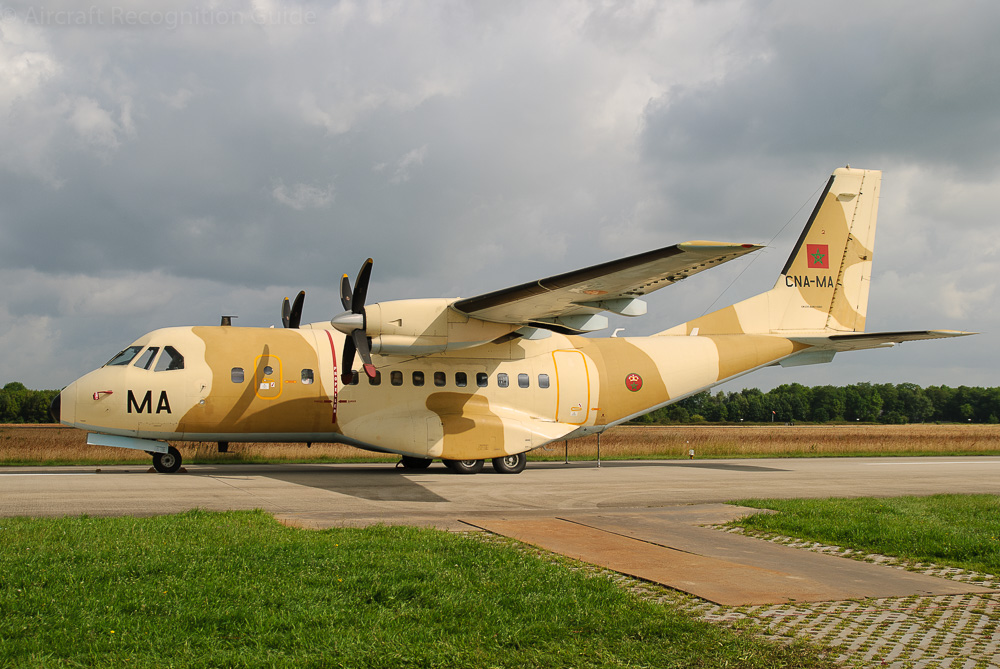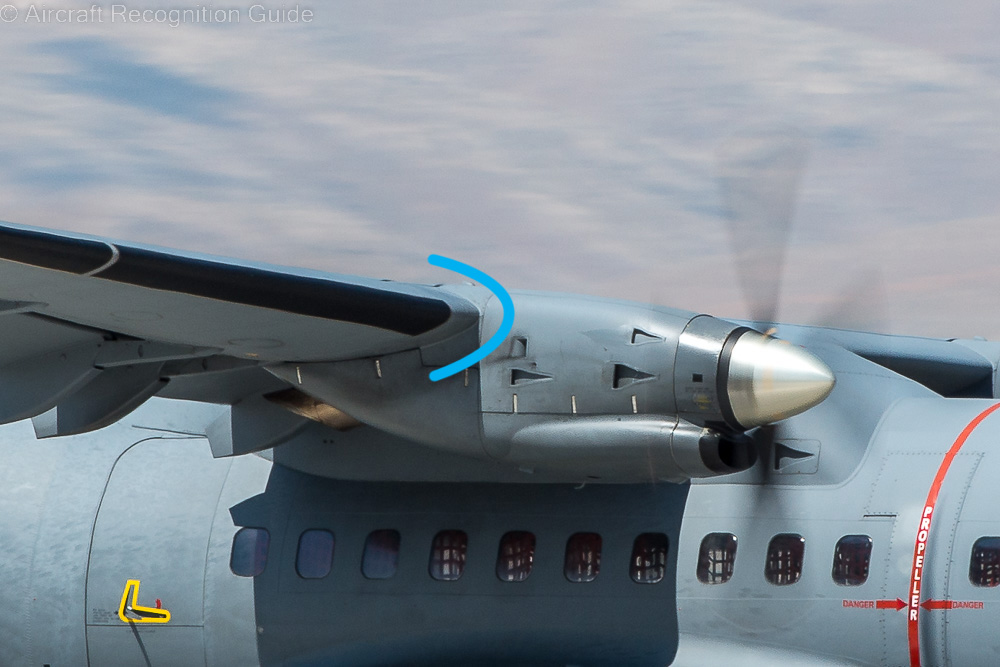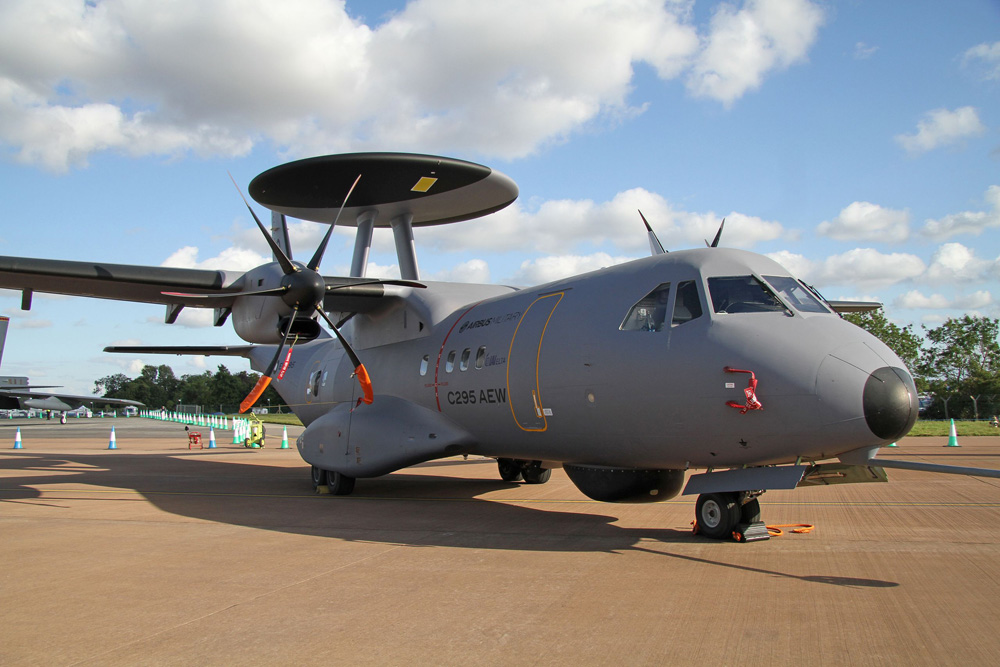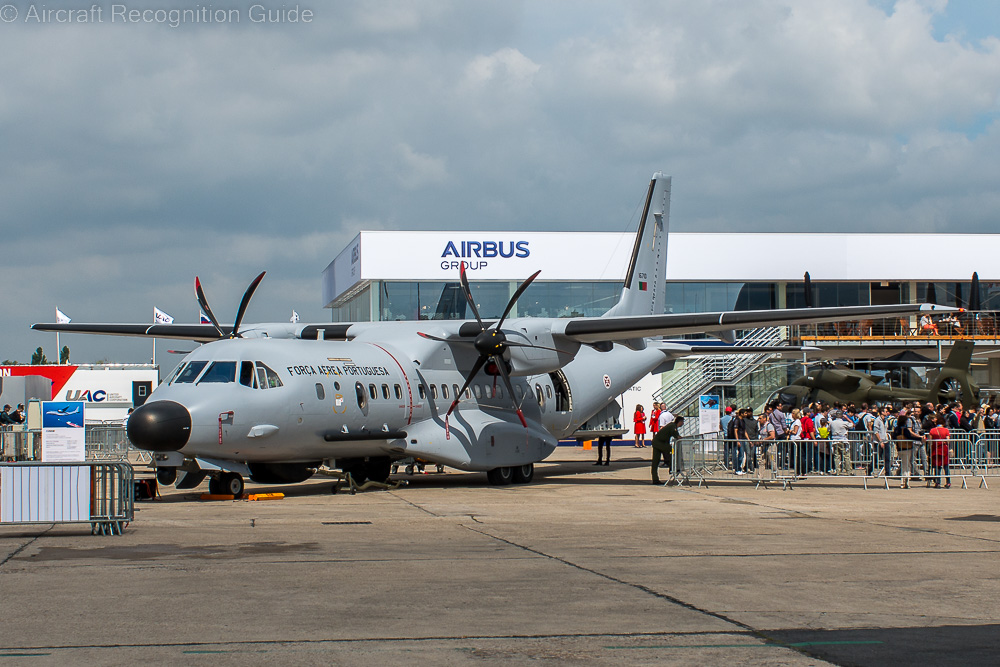
CASA-IPTN CN-235 & CASA C-295
The CN-235 was jointly developed by CASA of Spain and IPTN of Indonesia in the early 1980s, when a new generation of turboprop commuter aircraft saw light. Unlike the competitors the consortium (named Airtech International) focused on military customers, by giving the aircraft a rear loading ramp. Although relatively few aircraft were used for passenger transport, the aircraft was equipped with many cabin windows. The tandem main landing gear retracts in streamline bodies underneath the fuselage.
Later CASA alone made a stretched version, designated C-295. Both aircraft are now marketed by EADS/Airbus Military. However, Indonesian Aerospace maintains its own production line of the CN-235.
The nose and cockpit window arrangement is quite typical for the CN-235 and C-295.
Different versions
The different versions of the CN-235 and C-295 can be recognised by looking at:
- the length of the fuselage
- the length of the vertical stabiliser and rudder
- the number of nose wheels
- the number of propeller blades
- the shape of the wing leading edges
- the presence of winglets
- the presence of radomes/bulges under the fuselage, in the nose and/or on top of the fuselage
CN-235-10 (CN-235), CN-235-100/110, CN-235M-100
CN-235 was the start of the family of aircraft, and is the shortest of the two main models. Compared to the bigger C-295 it has four blade propellers, a single wheel nose gear as standard and a rudder that extends to the top of the vertical stabiliser.
The first version of the CN-235 was marketed as CN-235-10, but is officially known as only CN-235.
The second version was the CN-235-100 (built by CASA in Spain) and CN-235-110 (built by IPTN in Indonesia). Both have higher power engines in composite nacelles, but these seem to be externally not different from the metal ones on the CN-235-10. CN-235M-100 is the dedicated military variant of the -100, but externally not different as both have many cabin windows.
The CN-235-100M if the Moroccan air force is an example of the standard transport version of the CN-235. note the many cabin windows, also on the military version.
This detail shows the shape of the wing's leading edge close to the nacelle, to compare with the shape of later models described below.
CN-235-200/220 & CN-235M-200/220
The improved CN-235-200 (Spanish built) and CN-235-220 (Indonesian built) have a reinforced structure, allowing higher operating weights, and aerodynamical improvements to the wing leading edges and rudder. The wing leading edges have a different shape than on the earlier CN-235-10/100: it droops down a bit. Often, the de-icing boots show this best. CN-235M-200 is again the dedicated military version.
Although quite difficult to see, this CN-235M-220 can be distinguished from earlier models by looking at the shape of the leading edges of the wings. (photo: Tim Felce (Airwolfhound)/WikiMedia)
Zooming in on the wing-nacelle connection you can better see that the shape of the wing leading edges is different on the CN-235-200 and -300 compared to the -10 and -110.
CN-235-300 & CN-235M-300
Apart from having a new avionics suite, the CN-235-300 (and CN-235M-300) have the option to have a two wheel nose landing gear. So if you see a CN-235 with two nose wheels, it must be a -300 version. Otherwise, you cannot distinguish it from the CN-235-200/220.
This CN-235 has a double nose wheel, so it must be a -300, in this case a CN-235M-300.
CN-235MPA
All primary variants described above can be fitted out for maritime patrol duties. In that case they are called CN-235MPA, with the subtype in between. The MPA version has either a radar radome in the nose, under the nose and/or under the forward fuselage. Also, the MPA version can have pylons under the wings to store weapons.
The CN-235-300MPA Persuader used by the United States Coast Guard is designated HC-144A Ocean Sentry.
The CN-235MPA is the maritime patrol version of the CN-235. It can be recognised by bulges in the nose an/dor under the forward fuselage.
C-295M
The C-295M is the basic (military) transport version of the C-295, itself a three metre longer development of the CN-235. In addition, it has six blade propellers and two wheels on the nose gear as standard. Finally, the C-295 has a taller vertical stabiliser, with the rudder not extending to its top.
The Brazilian air force designates the C-295 as C-105.
The basic C-295M has no winglets and no radomes or other bulges.
C-295W (C-295FW)
A modernised version of the C-295 is the C-295W, of which the W in the name apparently comes from the winglets that have been added. The type certificate mentions desgination C-295FW though...
The C-295W has slightly canted winglets as standard, so is easily recognised. (photo: Shadman Samee/WikiMedia)
C-295 AEW
The C-295 is suitable as a platform for special missions. A C-295 that has a circular radar disk on top of the fuselage is marketed as C-295 AEW, of airborne early warning.
A C-295 with a radar disk on top of the fuselage is marketed as C-295 AEW. (photo: Ronnie Macdonald/WikiMedia)
C-295MPA
The C-295 has a maritime patrol version like the CN-235. It has a radar nose and/or bulge under the forward fuselage.
The Canadian military operate the MPA version of the C-295W and call it CC-295 Kingfisher. It has winglets but hardly any cabin windows.
The Brazilian have C-295MPA which they designate SC-105.
This Portugese C-295MPA has a radar nose, a bulge under the fuselage and a bar shaped antenna at the side of the fuselage.
Confusion possible with
Aeritalia G222 & Alenia C-27J
Both in terms of looks and potential customers the C-27J (developed from the G222) is the main competitor of the CN‑235 and C‑295. The G222/C‑27J has far fewer cabin windows, but more cockpit windows - above the head and at the feet of the pilots - and is generally less slender than the C‑295. There is some space between the tandem main wheels.
Fairchild C-123 Provider

The C-123 Provider looks more like the G222 above but could still be confused with the CN‑235/C‑295. It has different cockpit windows though, including at the cockpit crew's feet. The few cabin windows are square, there are no streamline bodies for the gear and the dorsal fin is much bigger and with two steps. Finally, it has radial piston engines, sometimes complemented by two jet engines under the wings.
Transall C-160
The C-160 has the same basic configuration, but is significantly bigger than the CN‑235 and C‑295. Also the C-160 has different cockpit windows, fewer cabin windows, a more square vertical tail and double wheels on the main landing gears.
Antonov An-26/An-32
The An-26 and An-32 are also high wing military transport aircraft with a rear loading ramp. However, both have long main landing gear legs retracting in the engine nacelles.
















